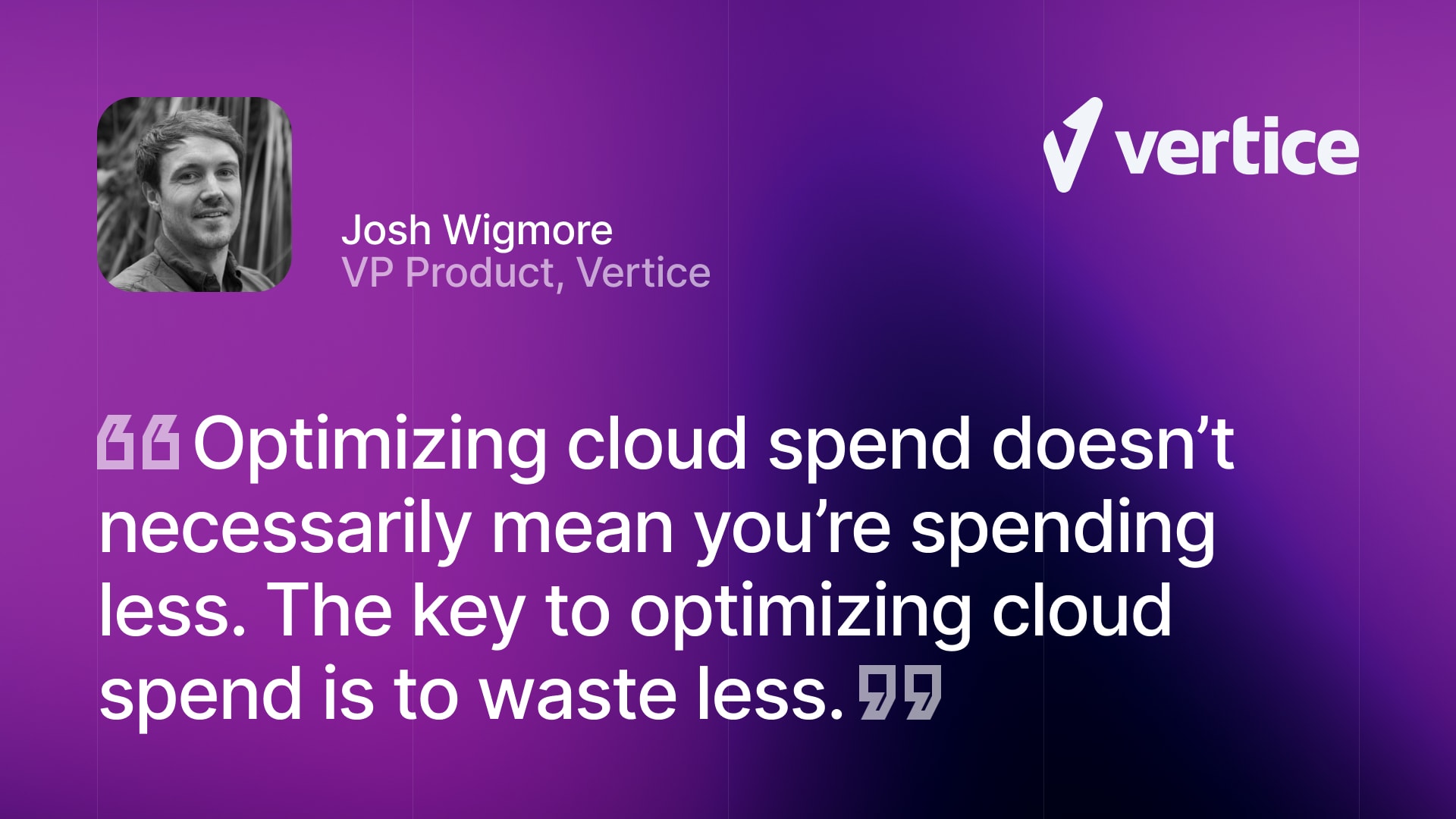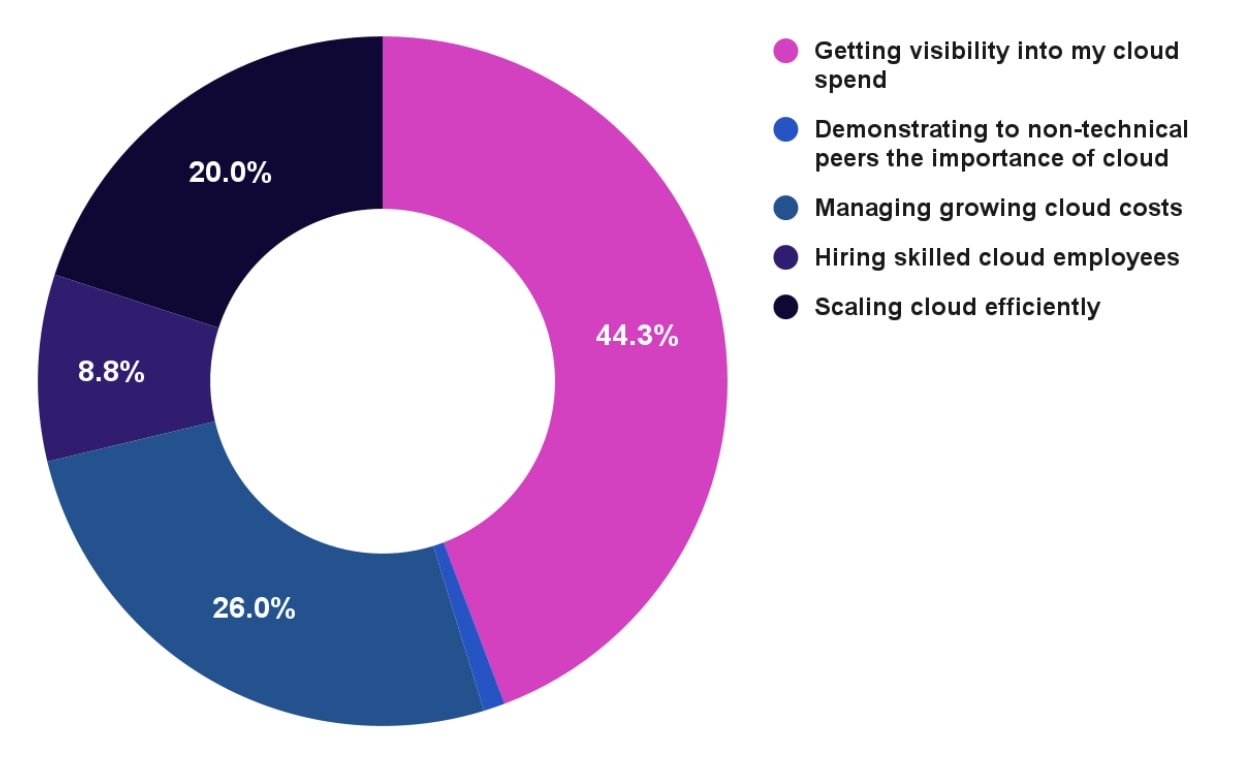The cloud visibility gap: A CFO’s guide to cutting cloud costs
Aimee Manning | NOV 02, 2023
11 min read
With the rapid surge in cloud spending becoming increasingly unsustainable for the majority of organizations, it’s never been more important for finance leaders to understand the drivers of these costs and take control of this spend.
For many though, this is easier said than done.
Why?
Because of the overwhelming lack of visibility into cloud spend and usage – a problem that’s become so challenging that almost half of all CFOs cite it as their number one cloud-related concern.
So, what’s the solution?
In our latest webinar, we spoke to the founder of GENCFO, Chris Argent, as well as our very own VP Product, Josh Wigmore, to answer just that.
Here are the key takeaways and insights.
Key takeaways from Chris Argent, Founder of GENCFO and Josh Wigmore, Vertice’s VP of Product
1. Cloud spend is the biggest savings priority for finance leaders, but how CFOs are approaching it widely differs
It’s no secret that costs are rising substantially in almost every area of business spending, from wages to office space, right through to software prices – a cost that we’ve previously acknowledged is spiraling out of control.
But while the exact amount being spent on each varies from company to company, we were keen to understand which areas CFOs believe are higher priorities for reducing waste in 2024.

According to the findings published in our 2024 Cloud Spend Report, the number one cost that finance leaders are looking to reduce are those incurred by cloud computing, followed by employee headcount and SaaS fees.
What’s interesting, however, is that despite being seen as a higher priority, in many organizations cloud spend is lower than both.
So, why is it such a high priority?
According to Chris, it largely comes down to the fact that cloud costs are more complex and volatile than other areas of business spending.
“Where a cost is either complex or volatile, it needs to be forecasted more regularly. The fact that cloud costs are both screams to a CFO that they need to be forecasting frequently and ultimately controlling this spend.”

Despite being a high priority, the way in which an organization tackles the issue of soaring cloud spend is very much dependent on the CFO.
“In my experience, there are typically three types of CFOs;
- digital first leaders that are leaning into technology and transformation and want to understand the drivers
- lagging CFOs that feel that tech isn’t for them, and there are other budget lines on the P+L they should be more worried about
- and then CFOs that are aware of the issue but want to delegate to someone that may have more knowledge.”
Chris continues to explain that these differences in the approach to cloud cost optimization can also extend to the size of a company.
“The biggest difference between organizations is materiality. The cost to a startup is going to be significant and will get that level of attention. In larger organizations, the cost may be lower than headcount and other areas of spending, and may not be seen as a priority at that time.”
2. The focus shouldn’t always be on reducing cloud spend, but rather cutting waste
With cloud spend increasing by an average of 35% year-on-year, it comes as little surprise that so many companies are desperate to reduce it. After all, as Chris rightly stated: “Any jump in cost is a concern”.
But cloud cost optimization is about more than just reducing your monthly bill.
According to Josh, “Optimizing cloud spend doesn’t necessarily mean you’re spending less. The key to optimizing cloud spend is to waste less”.

With our data indicating that close to a third (32%) of cloud expenditure goes entirely to waste, it’s evident that it’s a major issue that could be costing many organizations millions of dollars each year, given that the average company is spending upwards of $3.8 million on it.
Knowing where this waste exists is the first step in knowing where you should be allocating your resources.
“As a result of optimizing your cloud infrastructure, you may have more confidence in the cloud and decide to invest in more services that you feel are giving you better return on investment. While it may end up meaning a slightly higher bill down the line, you will have cut all the wastage out”, explains Josh.
“Ultimately, the cloud is an incredible resource for engineering teams and it’s part of what allows these teams to bring products to market so quickly and so efficiently. It’s about managing that and doing it in a way that considers cost at the same time.”
Identifying this waste is no easy feat, though. It requires a level of visibility and understanding that many CFOs simply don’t have.
“With most companies now going through digital transformation, having a basic understanding of IT knowledge is key in the finance space. The problem is, cloud is incredibly complex. There are a lot of different pricing models and services, and the lack of visibility is a problem for finance leaders. Many want to learn, but they don’t have the knowledge. If they had a way of getting that visibility and being able to have informed conversations, they would be there to support the management of cloud costs”, Chris explained. “I agree it’s definitely not just about cutting costs, it’s about rightsizing – how they can apply the right resources to the right business line to grow the revenues”.
3. CFOs need to be having quality conversations with their technical colleagues
With lack of cloud visibility preventing CFOs from getting a good handle on escalating costs and accurately forecasting spend, it’s unsurprising that it was rated the leading cloud-related concern.

“We found that there isn’t a general understanding among finance leaders of what actually contributes to the costs that can arise from cloud computing and how those costs are specifically related to the way a business functions or how it correlates to the revenue the business makes”, explained Josh.
The problem is, this lack of understanding – stemmed from a lack of visibility – is causing some degree of friction in many companies, with finance leaders relying heavily on their technical counterparts to obtain the necessary information.
This, in itself, is a major challenge, with 41% of CFOs claiming that the lack of transparency from technical staff is the number one relationship issue between the two teams. In contrast, only one in five tech leaders feel like executives, including CFOs, understand the nature of the cloud and its associated costs.
It’s clear that there’s a big problem on both sides.
Finance teams feel that their tech colleagues aren’t able to demonstrate cloud efficiency and are more concerned about growth and innovation than managing costs, whereas tech teams don’t believe that finance has the right knowledge or expertise to understand cloud investments – something that Chris believes is resulting in poor and ultimately pointless conversations between the two parties.
When it comes to the reason why, Josh thinks that one of the main issues is the lack of tools available to CFOs in helping them get the understanding required for more productive conversations and enabling them to ask the right questions.
“It was clear that there just weren’t the obvious access points for finance leaders to get the understanding they need about the cloud. This is why we built a cloud cost optimization tool within the Vertice platform, to help provide them with the visibility they need into their cloud spend and usage, while also giving them an understanding of the vocabulary and a high-level overview of the costs and services that can aid conversations with their tech colleagues.”
With the ability to not only view forecasted costs and predicted spikes in cloud spending, but also see where the opportunities exist to save if you’re willing to commit over the longer term, Josh believes CFOs will be equipped to have far more impactful conversations.
“These aren’t necessarily conversations and advice that the technical team will offer up, but if you have a tool that can show you these opportunities and give you a top-level understanding, it can be a great conversation starter.”
4. Organizations need to create a cost-aware culture
Ultimately, the long-term solution in closing the cloud visibility gap is to create a cost-aware culture across the organization.
This involves establishing financial accountability among all stakeholders, in other words, executing on a FinOps strategy.
Josh believes that creating an environment where technology teams start to put a dollar value against R&D development initiatives is a crucial first step.
“Whenever someone decides to create a new environment for development, or do a new piece of R&D and spin up a new database or machine learning module, you want them to consider the cost. If you start to build this awareness across both teams, you bring both finance and tech into the fold, rather than having a siloed situation which is what is currently happening in many businesses.”
Chris also acknowledges that by establishing a culture where there is mutual financial accountability for cloud spend, you can start to have business conversations, rather than specialist conversations.
When asked how finance leaders can overcome some of the cloud cost challenges and partner more effectively with their technical peers, he recommends that they get closer to the technology and build on internal relationships.
“This involves being open with the CTO or CIO and admitting that they don’t have a huge amount of knowledge in this space, but that they want to learn and that it will require a bit of education.This requires a level of vulnerability, but it is not always a comfortable position for a CFO to be in.”
They may also have people within their own teams that they can lean on to support these conversations.
“Finance people in leadership positions who are responsible for scrutinizing this budget may have internal resources that can talk tech better than them. Go and find these people that can help you build these relationships.”
Ultimately, by providing all stakeholders with a unified and simplified view of both cloud spend and usage, friction can be reduced, collaboration can be increased and organizations can establish financial accountability among all stakeholders.
Closing the cloud visibility gap with Vertice
Regardless of the impact cloud costs are having on your organization, as a CFO it’s important to effectively articulate why these costs are increasing, the steps taken to eliminate wastage and ultimately how this spend ties back to business performance.
At Vertice, we’ve developed a tool that will provide you with the visibility and insights you need to do just that.
That’s not all it does, though.
By analyzing your cloud infrastructure using more than 75 optimization tests, we can generate a number of actionable cost-saving recommendations that can either be automated or require minimal engineering support.
And that could save you up to 25% on your annual cloud spend.
See for yourself how Vertice discovered over $1 million in cloud savings potential for one company, or alternatively, get a better idea of the benefits of working with a FinOps partner.


